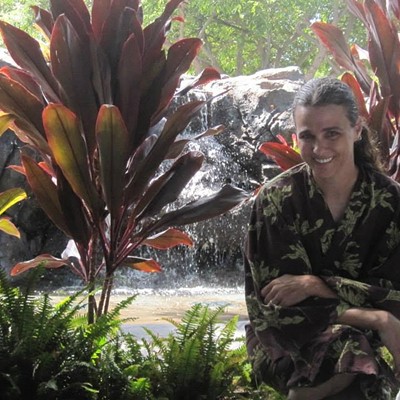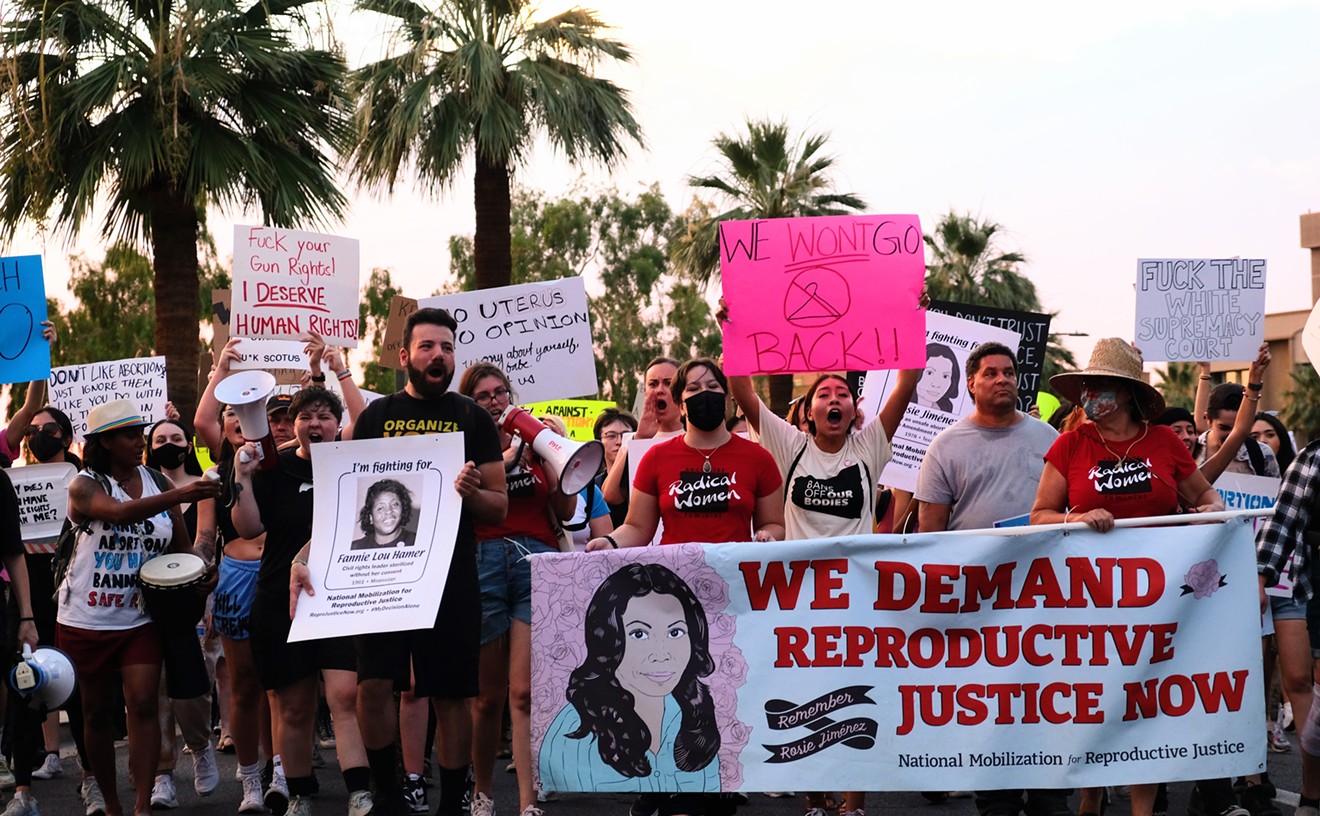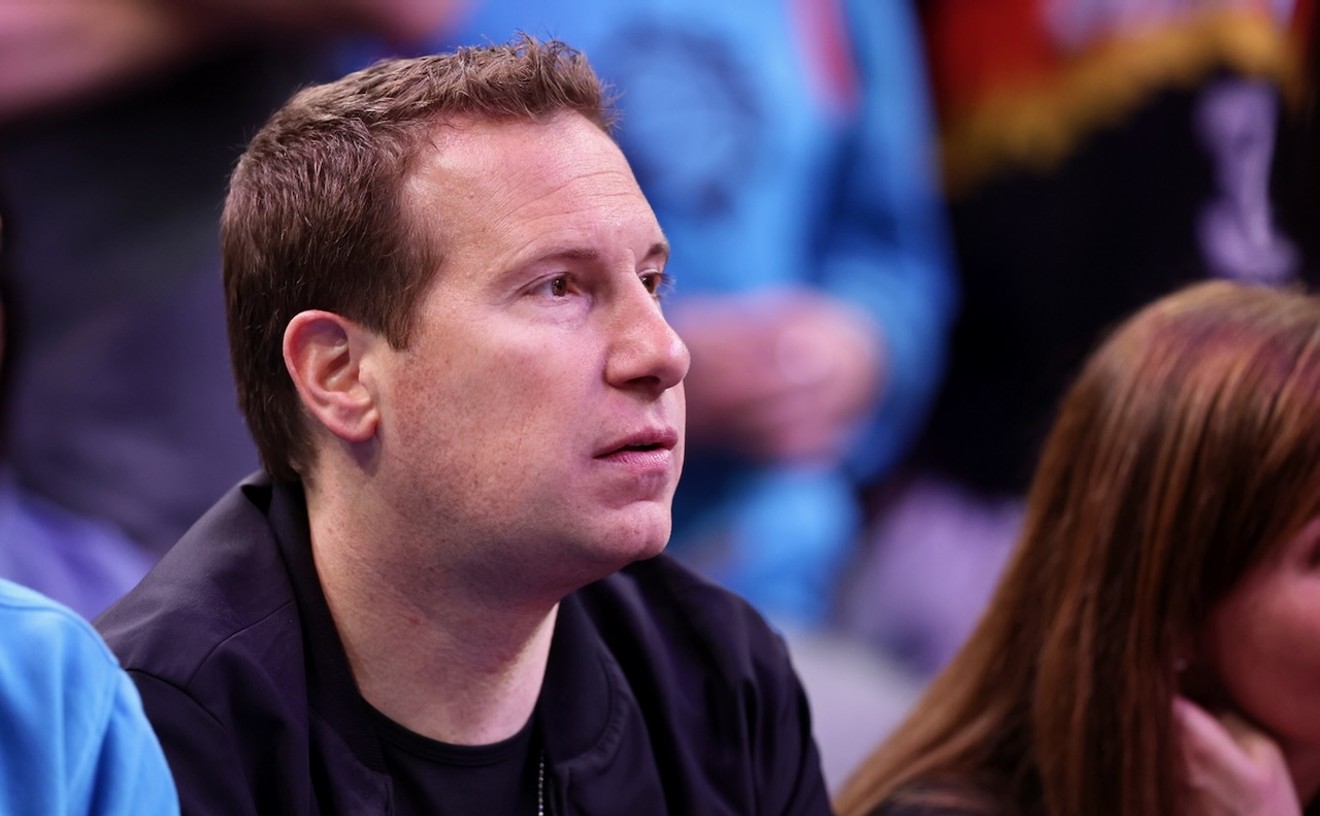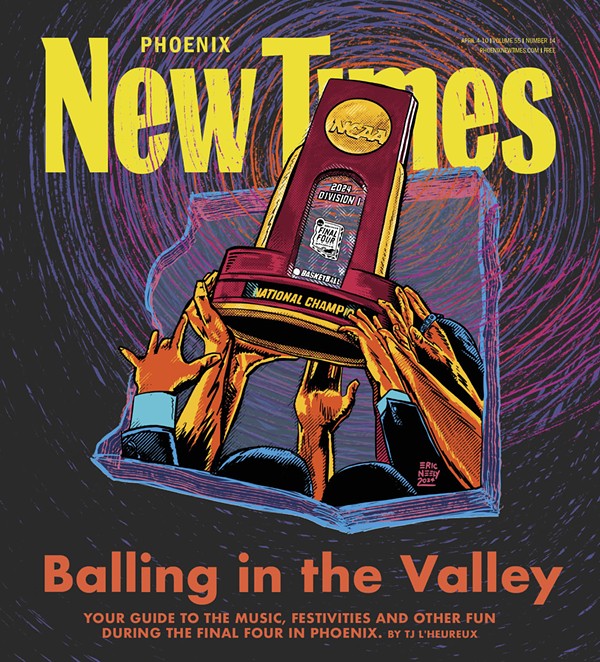It's a muggy Sunday night in mid-June, and Robyn Milton is celebrating her 30th birthday (for the eighth time) with a party in the backyard of a pal's north Phoenix home. She's about to liven up the party for her guests.
"Hey, my friend brought this stuff," she says. "And I've been dying to try it. It's supposed to get you high. Everybody needs to do some with me."
The "stuff" is divvied up and everybody does some. Ten minutes later, Robyn and her guests are pacing the backyard, rubbing their faces, talking over each other in multiple conversations, trying to push each other into the pool, and insisting, "We should do some more."
There's more where that came from, for sure. The guy who's the biggest seller of the stuff in the state even offered to give me a mirror and a couple of extra vials with it.
But this isn't cocaine. It's the latest trend in edgy European liqueurs, a green brew called Agwa de Bolivia Coca Leaf Liqueur.
Since making its way to bars and liquor stores across the Valley this spring, Agwa de Bolivia has built a reputation as a mystery liquor that's highly intoxicating, yet strangely energizing, too. It's not the tastiest thing to drink straight, but seems to mix well with almost anything. It's being hailed as "the new absinthe" by some, "the new Jägermeister" by others, and being celebrated as everything from an alleged booster of sexual prowess to a substitute for illegal drugs.
Jeremy Johnson, co-owner of Homme in central Phoenix, says Agwa's been selling so well at his club that he ran out a couple of weekends ago and had to increase his order. The liqueur has its appeal as a novelty drink among the younger crowd, but also holds a nostalgic kick for older folks whose drug-doing days are over.
Throw in the idea that Agwa can increase sexual potency (a claim made by numerous college guys on Internet forums), and you've got the perfect party drink for yuppies, Yippies, hippies, and pretty much everyone in between.
Agwa's hook is the "Agwa buzz," a heady rush followed by a period of sustained, mildly euphoric energy — a similar feeling to that induced by cocaine.
"It does get you high," says Rich Naegeli, the broker/distributor for Agwa in Arizona and New Mexico. "If you drink enough of it, it will actually get you high."
Whether or not Agwa has the properties to really get you high doesn't matter, at least not at Robyn Milton's birthday party.
"I feel pretty damn good!" Robyn's husband, Chuckie, says, as his guests scour the kitchen cabinets for mixer liquors, perhaps something melon-flavored. "I feel like I could party all night!"
Agwa de Bolivia Coca Leaf Liqueur looks like watered-down NyQuil cough syrup, and smells about the same. I knocked back a double shot of it on a Tuesday night a few weeks back, after hearing about the drink and rushing out to buy a bottle. I bit into a lime, then did the shot. There was a tingling in the back of my throat, similar to a tequila burn, followed by a slightly minty, fruity aftertaste. Even though it was pungent and harsh, I did two more double shots of the drink and called it a night. Agwa de Bolivia is 60-proof alcohol, so I should have been slumbering shortly after downing a quarter of a bottle.
But by 4 a.m., it was clear that I wasn't going to fall asleep anytime soon. My head was buzzing, and I was absolutely wired awake. I decided to mow the lawn after alphabetizing my vinyl record collection.
Could it be true that Agwa had me flickering on its reputed "cocaine buzz"? After all, the drink is made from the leaves of the coca plant, the same plant that produces cocaine. I'd heard about the drink from a handful of barfly and bon vivant friends, and the general consensus among them was that they weren't sure if Agwa de Bolivia made them feel "high" but that it most definitely made them feel "drunk," "funny," and "different."
I'd also heard that Agwa was a more potent herbal liqueur than Jägermeister, but a comparative review on liquorsnob.com declared, "[Agwa] offers a crazy buzz, a funky flavor, and a good marketing campaign. In our opinion, it's an interesting and unique liqueur, but it doesn't have what it takes to become the true classic Jägermeister is."
Curious about the "crazy buzz" and "funky flavor," I wanted to try it, too, but it was still relatively new to my friends and they only knew of one bar and one liquor store that was selling it. Turns out, Agwa's available at more than 48 locations around the Valley, including clubs like TT Roadhouse in Scottsdale, Shady's in Phoenix, and Tavern on Mill in Tempe, and at all BevMo!, Tops, and AJ's Fine Foods locations.
That's perfectly legal because there's no cocaine in Agwa de Bolivia Coca Leaf Liqueur.
True, the drink is made from the leaves of the coca plant, the same plant from which cocaine is derived after a long process involving solvents and other chemicals, but the kick's been taken out of the coca, so to speak, by the time it hits the Agwa recipe, which also includes ginseng, green tea, and a natural source of caffeine called guarana. But that hasn't stopped Agwa's marketing gurus from playing up the coke jokes — nor has it curbed consumer curiosity about the drink's alleged effects.
"A favorite way of drinking Agwa is with an energy drink," says Brad Henrich, owner of both TT Roadhouse and Shady's. "It's sort of an energy liquor."
Many people describe Agwa's impact as more of a high than a drunk. And Naegeli is quick to point out at that it's a perfectly legal — albeit perfectly psychological — high.
"Once you do drink it and have a couple shots of it, you'll feel a different feeling. Rather than actually getting drunk, you'll get a little buzz, like a drug high, but it's perfectly legal," he says. "The alkaloids that would normally test positive for drugs have been removed."
"It's great on the rocks," says Homme co-owner Jeremy Johnson, "as long as you're ready to party."
Agwa is just the latest spirit in a centuries-old tradition of coca-based drinks. Coca leaves have been used in drink recipes for hundreds of years by the Andean peoples of South America, and the leaves continue to be a vibrant part of the culture. In Bolivia, a drink called mate de coca is almost as popular as tea and coffee. In Colombia, the Nasa Indians make and sell a brew called Coca-Sek, a carbonated energy drink containing syrup from boiled coca leaves.
And North American soft drink giant Coca-Cola has used coca leaves in its mysterious recipe since 1885, when Georgia entrepreneur John Stith Pemberton concocted the first recipe for Pemberton's French Wine Coca and changed the recipe to a non-alcoholic brew after Prohibition the following year. Coca-Cola's super-secret formula has changed over the years, but Pemberton's original concoction contained five ounces of coca leaf per gallon of syrup. (Since 1904, Coca-Cola has used leaves from which the cocaine alkaloids have been removed).
Importation of coca leaves into the United States is illegal, but one chemical company — the Stepan Company of Maywood, New Jersey — has the only commercial license from the Drug Enforcement Agency to import coca leaves into the U.S. The Stepan Company imports and processes the leaves for two companies: Mallinckdrodt, a pharmaceutical company, and Coca-Cola. The cocaine alkaloids are removed to provide Coca-Cola with a non-narcotic extract for flavoring, and the narcotic ingredient is sold to Mallinckdrodt for medicinal purposes.
As with Coca-Cola, the makers of Agwa de Bolivia Coca Leaf Liqueur — the Bapco International Company of Dublin, Ireland — use an extract of "spent" leaves left over from a maceration and distillation process that removes the cocaine alkaloids. Bapco distills coca leaves shipped from Bolivia to Amsterdam, where Agwa de Bolivia is manufactured from a benign coca extract. Importation of the finished product into the United States is legal, although the U.S. version of the drink contains 32 milligrams of coca leaf extract, as opposed to the 40 milligrams of extract found in the European version.
Even though Agwa's not illegal, the hype's enough to get you high. And if that doesn't do it, the massive amounts of guarana — a plant whose seeds contain five times the amount of caffeine of a coffee bean — will. Even tempered by other alcohols in mixed drinks, Agwa's dynamite dosage of herbal caffeine could make a catatonic twitch.
Agwa de Bolivia Coca Leaf Liqueur is allegedly made from a recipe used by the famed Medici family of Florence, Italy. Babco CEO Mark Wilson (also the man behind the Mickey Finns Schnapps brand) tells this story: The Agwa recipe is derived from that of Jean Buton, who was a primary business associate of Napoleon Bonaparte. Buton married the Countess Sassoli — whom Wilson says was "the last in line of the Medici" — and upon Napoleon's demise, Buton fled France and began producing coca leaf liquor in Bologna, Italy, in 1820. The drink was hugely popular in Europe but disappeared when cocaine was banned.
"We took inspiration from their work and re-designed the coca leaf liquid to accommodate current laws by ensuring that the banned cocaine alkaloid was not present," Wilson says. "However, the coca leaf has many more mysteries and indeed benefits than the abused cocaine."
Agwa de Bolivia found its way through Europe and into Canada by 2004 but was available only sporadically in places throughout the U.S. because of problems with flaky distributors. Brad Henrich has been a fan of Agwa for years and says TT Roadhouse started serving it when it became available in 2004.
"It was a hit over [at TT Roadhouse] as a shot and in mixed drinks," he says. "We're big fans of it."
Henrich's happy to see the recent distribution boost and has started offering Agwa drinks at Shady's, too. With Young's Market in Orange County, California, now serving as a national distributor, Agwa de Bolivia has been widely available in Phoenix for at least a year, with buzz building in bars during the past couple of months.
People want to know whether the drink will make them feel like they're on cocaine, or whether it's as strong as absinthe or Jägermeister. The effects of the liqueur vary for each drinker, but one thing's fairly certain: It's a potent brew. "The herbal liqueur we developed is different from any normal alcohol experience," Babco CEO Wilson says. "But responsibly, we suggest never to drink more than three."
Representatives of Agwa de Bolivia Coca Leaf Liqueur are quick to clarify that the drink does not contain cocaine; they blame the media for the hype. When the drink first appeared in Toronto in 2000, Agwa's maker released a press statement in which Babco International North American Vice President Andrew Stodart said, "Claims that Agwa contains cocaine are false . . . Agwa's cocaine-in-a-bottle reputation did not come from Babco. The coca leaf spirit drink contains no actual cocaine but has been reported to induce a more interesting effect than traditional spirits by consumers and the press in various countries."
Simultaneously, the marketing campaigns behind Agwa have clearly played off the faux blow angle. Slogans have included "Alco-Jolt," "Melts in your mouth, not in your nose," and "lqdblo." South American natives are said to chew raw coca leaves with lime to release the cocaine alkaloids from the leaf, and many Agwa drink recipes include limes or lime powder. One marketing kit even included an Agwa de Bolivia mirror, vials of lime powder, and straws.
Regional Agwa distributor Rich Naegeli admits the props are as much fun as the drink.
"I have a neighbor that's an ex-Tempe cop," Naegeli says. "And I've got him to where he loves Agwa, and one day he came down to the house and I had the mirror on the table and everything all set out, and he said, 'Rich, what're you doing?' and I said, 'Wanna do a lime with me?'
"And he asked to borrow the mirror because he was having a party with his cop friends and wanted to have the mirror on the table to kind of freak them out.
"That's the fun thing. You can play with it. You can be as bad boy as you want with it, or as innocent as you want with it."
But, no, it won't get you high. Not really.











